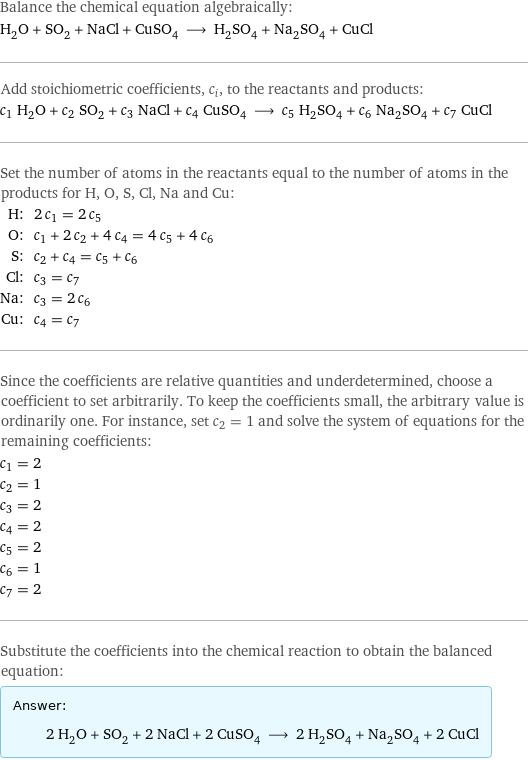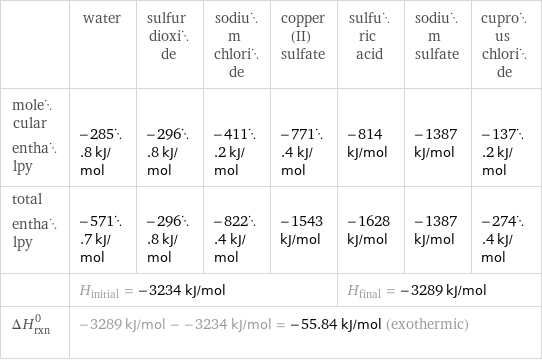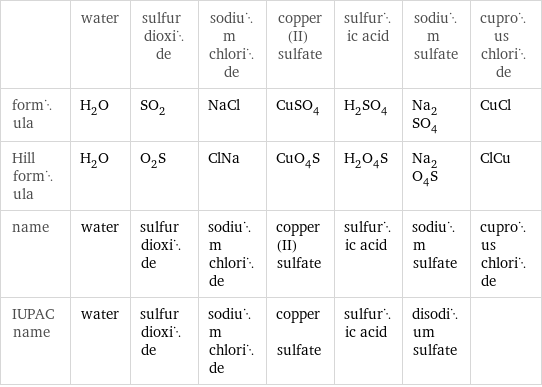Input interpretation

H_2O water + SO_2 sulfur dioxide + NaCl sodium chloride + CuSO_4 copper(II) sulfate ⟶ H_2SO_4 sulfuric acid + Na_2SO_4 sodium sulfate + CuCl cuprous chloride
Balanced equation

Balance the chemical equation algebraically: H_2O + SO_2 + NaCl + CuSO_4 ⟶ H_2SO_4 + Na_2SO_4 + CuCl Add stoichiometric coefficients, c_i, to the reactants and products: c_1 H_2O + c_2 SO_2 + c_3 NaCl + c_4 CuSO_4 ⟶ c_5 H_2SO_4 + c_6 Na_2SO_4 + c_7 CuCl Set the number of atoms in the reactants equal to the number of atoms in the products for H, O, S, Cl, Na and Cu: H: | 2 c_1 = 2 c_5 O: | c_1 + 2 c_2 + 4 c_4 = 4 c_5 + 4 c_6 S: | c_2 + c_4 = c_5 + c_6 Cl: | c_3 = c_7 Na: | c_3 = 2 c_6 Cu: | c_4 = c_7 Since the coefficients are relative quantities and underdetermined, choose a coefficient to set arbitrarily. To keep the coefficients small, the arbitrary value is ordinarily one. For instance, set c_2 = 1 and solve the system of equations for the remaining coefficients: c_1 = 2 c_2 = 1 c_3 = 2 c_4 = 2 c_5 = 2 c_6 = 1 c_7 = 2 Substitute the coefficients into the chemical reaction to obtain the balanced equation: Answer: | | 2 H_2O + SO_2 + 2 NaCl + 2 CuSO_4 ⟶ 2 H_2SO_4 + Na_2SO_4 + 2 CuCl
Structures

+ + + ⟶ + +
Names

water + sulfur dioxide + sodium chloride + copper(II) sulfate ⟶ sulfuric acid + sodium sulfate + cuprous chloride
Reaction thermodynamics
Enthalpy

| water | sulfur dioxide | sodium chloride | copper(II) sulfate | sulfuric acid | sodium sulfate | cuprous chloride molecular enthalpy | -285.8 kJ/mol | -296.8 kJ/mol | -411.2 kJ/mol | -771.4 kJ/mol | -814 kJ/mol | -1387 kJ/mol | -137.2 kJ/mol total enthalpy | -571.7 kJ/mol | -296.8 kJ/mol | -822.4 kJ/mol | -1543 kJ/mol | -1628 kJ/mol | -1387 kJ/mol | -274.4 kJ/mol | H_initial = -3234 kJ/mol | | | | H_final = -3289 kJ/mol | | ΔH_rxn^0 | -3289 kJ/mol - -3234 kJ/mol = -55.84 kJ/mol (exothermic) | | | | | |
Gibbs free energy

| water | sulfur dioxide | sodium chloride | copper(II) sulfate | sulfuric acid | sodium sulfate | cuprous chloride molecular free energy | -237.1 kJ/mol | -300.1 kJ/mol | -384.1 kJ/mol | -662.2 kJ/mol | -690 kJ/mol | -1270 kJ/mol | -119.9 kJ/mol total free energy | -474.2 kJ/mol | -300.1 kJ/mol | -768.2 kJ/mol | -1324 kJ/mol | -1380 kJ/mol | -1270 kJ/mol | -239.8 kJ/mol | G_initial = -2867 kJ/mol | | | | G_final = -2890 kJ/mol | | ΔG_rxn^0 | -2890 kJ/mol - -2867 kJ/mol = -23.1 kJ/mol (exergonic) | | | | | |
Equilibrium constant
![Construct the equilibrium constant, K, expression for: H_2O + SO_2 + NaCl + CuSO_4 ⟶ H_2SO_4 + Na_2SO_4 + CuCl Plan: • Balance the chemical equation. • Determine the stoichiometric numbers. • Assemble the activity expression for each chemical species. • Use the activity expressions to build the equilibrium constant expression. Write the balanced chemical equation: 2 H_2O + SO_2 + 2 NaCl + 2 CuSO_4 ⟶ 2 H_2SO_4 + Na_2SO_4 + 2 CuCl Assign stoichiometric numbers, ν_i, using the stoichiometric coefficients, c_i, from the balanced chemical equation in the following manner: ν_i = -c_i for reactants and ν_i = c_i for products: chemical species | c_i | ν_i H_2O | 2 | -2 SO_2 | 1 | -1 NaCl | 2 | -2 CuSO_4 | 2 | -2 H_2SO_4 | 2 | 2 Na_2SO_4 | 1 | 1 CuCl | 2 | 2 Assemble the activity expressions accounting for the state of matter and ν_i: chemical species | c_i | ν_i | activity expression H_2O | 2 | -2 | ([H2O])^(-2) SO_2 | 1 | -1 | ([SO2])^(-1) NaCl | 2 | -2 | ([NaCl])^(-2) CuSO_4 | 2 | -2 | ([CuSO4])^(-2) H_2SO_4 | 2 | 2 | ([H2SO4])^2 Na_2SO_4 | 1 | 1 | [Na2SO4] CuCl | 2 | 2 | ([CuCl])^2 The equilibrium constant symbol in the concentration basis is: K_c Mulitply the activity expressions to arrive at the K_c expression: Answer: | | K_c = ([H2O])^(-2) ([SO2])^(-1) ([NaCl])^(-2) ([CuSO4])^(-2) ([H2SO4])^2 [Na2SO4] ([CuCl])^2 = (([H2SO4])^2 [Na2SO4] ([CuCl])^2)/(([H2O])^2 [SO2] ([NaCl])^2 ([CuSO4])^2)](../image_source/d8fd3e9fd4ed373b33ca7ada73763c3f.png)
Construct the equilibrium constant, K, expression for: H_2O + SO_2 + NaCl + CuSO_4 ⟶ H_2SO_4 + Na_2SO_4 + CuCl Plan: • Balance the chemical equation. • Determine the stoichiometric numbers. • Assemble the activity expression for each chemical species. • Use the activity expressions to build the equilibrium constant expression. Write the balanced chemical equation: 2 H_2O + SO_2 + 2 NaCl + 2 CuSO_4 ⟶ 2 H_2SO_4 + Na_2SO_4 + 2 CuCl Assign stoichiometric numbers, ν_i, using the stoichiometric coefficients, c_i, from the balanced chemical equation in the following manner: ν_i = -c_i for reactants and ν_i = c_i for products: chemical species | c_i | ν_i H_2O | 2 | -2 SO_2 | 1 | -1 NaCl | 2 | -2 CuSO_4 | 2 | -2 H_2SO_4 | 2 | 2 Na_2SO_4 | 1 | 1 CuCl | 2 | 2 Assemble the activity expressions accounting for the state of matter and ν_i: chemical species | c_i | ν_i | activity expression H_2O | 2 | -2 | ([H2O])^(-2) SO_2 | 1 | -1 | ([SO2])^(-1) NaCl | 2 | -2 | ([NaCl])^(-2) CuSO_4 | 2 | -2 | ([CuSO4])^(-2) H_2SO_4 | 2 | 2 | ([H2SO4])^2 Na_2SO_4 | 1 | 1 | [Na2SO4] CuCl | 2 | 2 | ([CuCl])^2 The equilibrium constant symbol in the concentration basis is: K_c Mulitply the activity expressions to arrive at the K_c expression: Answer: | | K_c = ([H2O])^(-2) ([SO2])^(-1) ([NaCl])^(-2) ([CuSO4])^(-2) ([H2SO4])^2 [Na2SO4] ([CuCl])^2 = (([H2SO4])^2 [Na2SO4] ([CuCl])^2)/(([H2O])^2 [SO2] ([NaCl])^2 ([CuSO4])^2)
Rate of reaction
![Construct the rate of reaction expression for: H_2O + SO_2 + NaCl + CuSO_4 ⟶ H_2SO_4 + Na_2SO_4 + CuCl Plan: • Balance the chemical equation. • Determine the stoichiometric numbers. • Assemble the rate term for each chemical species. • Write the rate of reaction expression. Write the balanced chemical equation: 2 H_2O + SO_2 + 2 NaCl + 2 CuSO_4 ⟶ 2 H_2SO_4 + Na_2SO_4 + 2 CuCl Assign stoichiometric numbers, ν_i, using the stoichiometric coefficients, c_i, from the balanced chemical equation in the following manner: ν_i = -c_i for reactants and ν_i = c_i for products: chemical species | c_i | ν_i H_2O | 2 | -2 SO_2 | 1 | -1 NaCl | 2 | -2 CuSO_4 | 2 | -2 H_2SO_4 | 2 | 2 Na_2SO_4 | 1 | 1 CuCl | 2 | 2 The rate term for each chemical species, B_i, is 1/ν_i(Δ[B_i])/(Δt) where [B_i] is the amount concentration and t is time: chemical species | c_i | ν_i | rate term H_2O | 2 | -2 | -1/2 (Δ[H2O])/(Δt) SO_2 | 1 | -1 | -(Δ[SO2])/(Δt) NaCl | 2 | -2 | -1/2 (Δ[NaCl])/(Δt) CuSO_4 | 2 | -2 | -1/2 (Δ[CuSO4])/(Δt) H_2SO_4 | 2 | 2 | 1/2 (Δ[H2SO4])/(Δt) Na_2SO_4 | 1 | 1 | (Δ[Na2SO4])/(Δt) CuCl | 2 | 2 | 1/2 (Δ[CuCl])/(Δt) (for infinitesimal rate of change, replace Δ with d) Set the rate terms equal to each other to arrive at the rate expression: Answer: | | rate = -1/2 (Δ[H2O])/(Δt) = -(Δ[SO2])/(Δt) = -1/2 (Δ[NaCl])/(Δt) = -1/2 (Δ[CuSO4])/(Δt) = 1/2 (Δ[H2SO4])/(Δt) = (Δ[Na2SO4])/(Δt) = 1/2 (Δ[CuCl])/(Δt) (assuming constant volume and no accumulation of intermediates or side products)](../image_source/afd53ba53944378467ec32a593825504.png)
Construct the rate of reaction expression for: H_2O + SO_2 + NaCl + CuSO_4 ⟶ H_2SO_4 + Na_2SO_4 + CuCl Plan: • Balance the chemical equation. • Determine the stoichiometric numbers. • Assemble the rate term for each chemical species. • Write the rate of reaction expression. Write the balanced chemical equation: 2 H_2O + SO_2 + 2 NaCl + 2 CuSO_4 ⟶ 2 H_2SO_4 + Na_2SO_4 + 2 CuCl Assign stoichiometric numbers, ν_i, using the stoichiometric coefficients, c_i, from the balanced chemical equation in the following manner: ν_i = -c_i for reactants and ν_i = c_i for products: chemical species | c_i | ν_i H_2O | 2 | -2 SO_2 | 1 | -1 NaCl | 2 | -2 CuSO_4 | 2 | -2 H_2SO_4 | 2 | 2 Na_2SO_4 | 1 | 1 CuCl | 2 | 2 The rate term for each chemical species, B_i, is 1/ν_i(Δ[B_i])/(Δt) where [B_i] is the amount concentration and t is time: chemical species | c_i | ν_i | rate term H_2O | 2 | -2 | -1/2 (Δ[H2O])/(Δt) SO_2 | 1 | -1 | -(Δ[SO2])/(Δt) NaCl | 2 | -2 | -1/2 (Δ[NaCl])/(Δt) CuSO_4 | 2 | -2 | -1/2 (Δ[CuSO4])/(Δt) H_2SO_4 | 2 | 2 | 1/2 (Δ[H2SO4])/(Δt) Na_2SO_4 | 1 | 1 | (Δ[Na2SO4])/(Δt) CuCl | 2 | 2 | 1/2 (Δ[CuCl])/(Δt) (for infinitesimal rate of change, replace Δ with d) Set the rate terms equal to each other to arrive at the rate expression: Answer: | | rate = -1/2 (Δ[H2O])/(Δt) = -(Δ[SO2])/(Δt) = -1/2 (Δ[NaCl])/(Δt) = -1/2 (Δ[CuSO4])/(Δt) = 1/2 (Δ[H2SO4])/(Δt) = (Δ[Na2SO4])/(Δt) = 1/2 (Δ[CuCl])/(Δt) (assuming constant volume and no accumulation of intermediates or side products)
Chemical names and formulas

| water | sulfur dioxide | sodium chloride | copper(II) sulfate | sulfuric acid | sodium sulfate | cuprous chloride formula | H_2O | SO_2 | NaCl | CuSO_4 | H_2SO_4 | Na_2SO_4 | CuCl Hill formula | H_2O | O_2S | ClNa | CuO_4S | H_2O_4S | Na_2O_4S | ClCu name | water | sulfur dioxide | sodium chloride | copper(II) sulfate | sulfuric acid | sodium sulfate | cuprous chloride IUPAC name | water | sulfur dioxide | sodium chloride | copper sulfate | sulfuric acid | disodium sulfate |